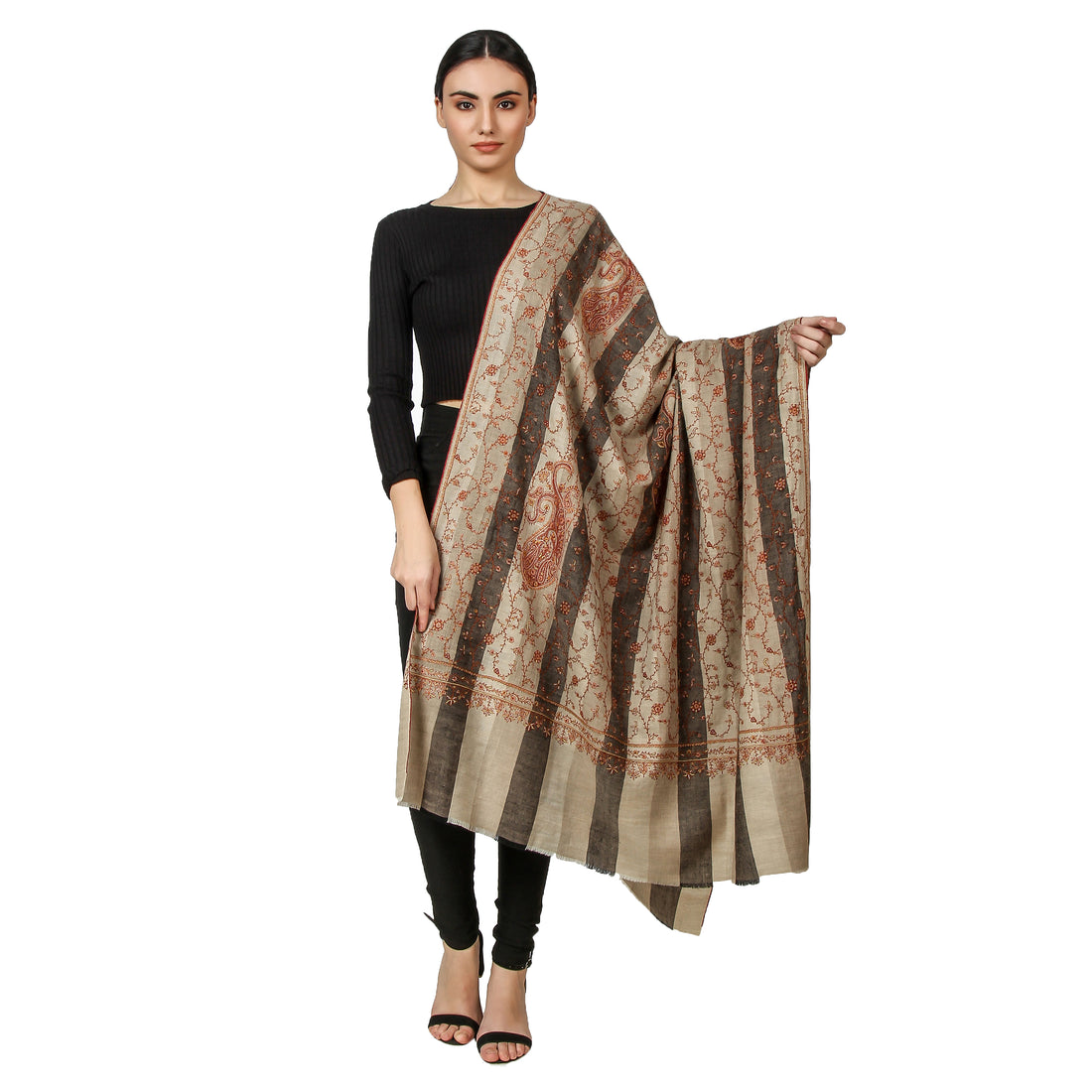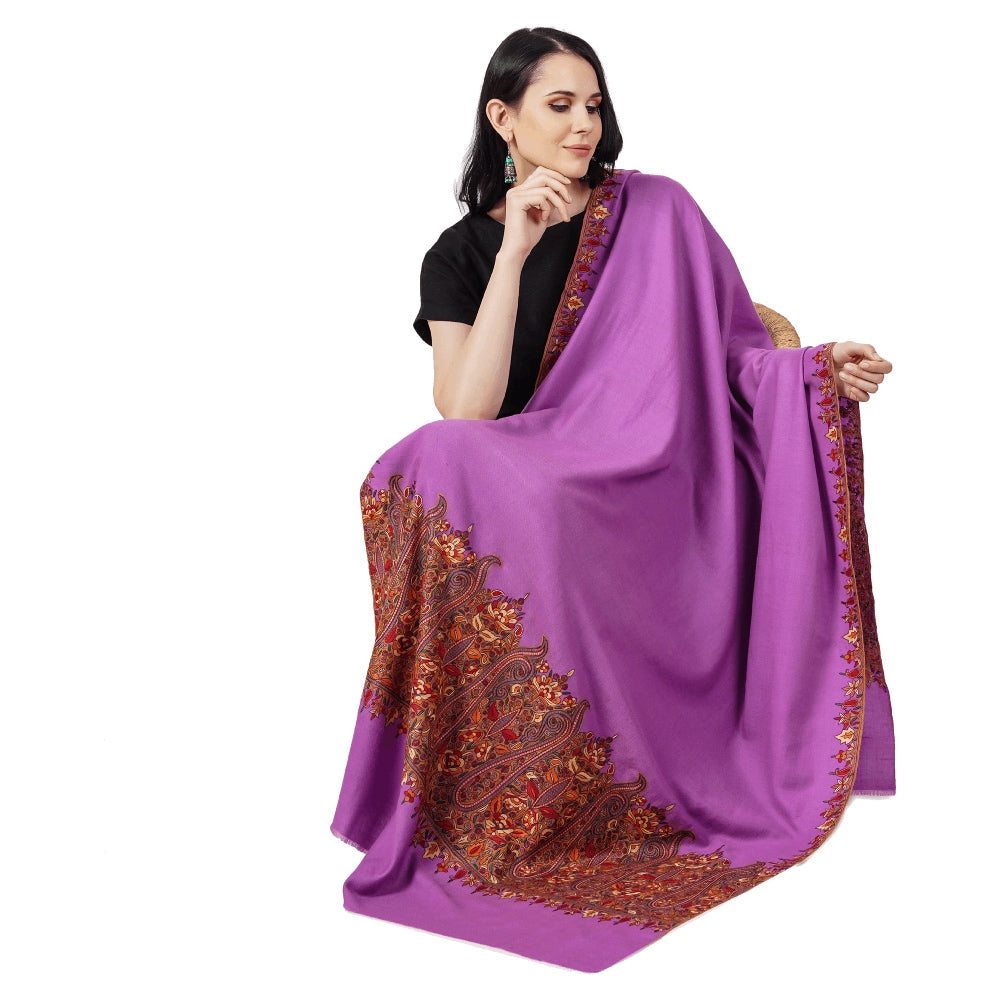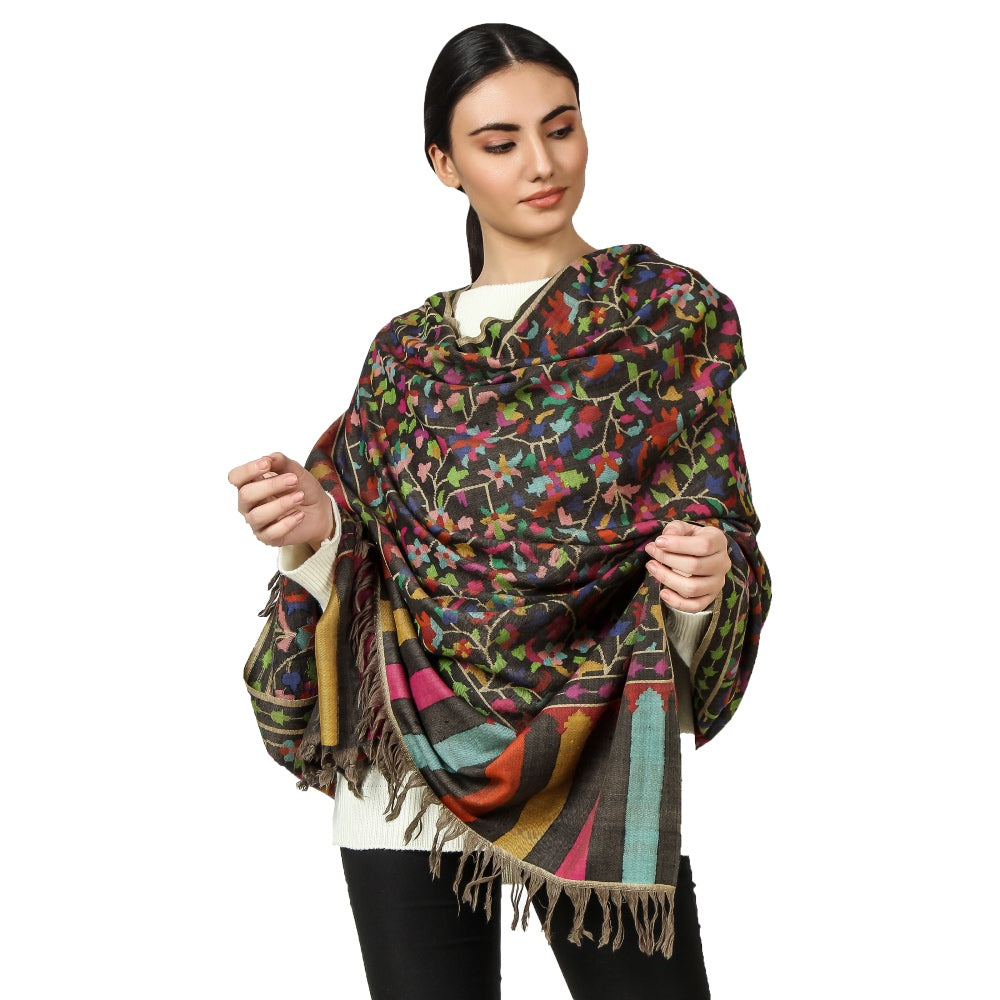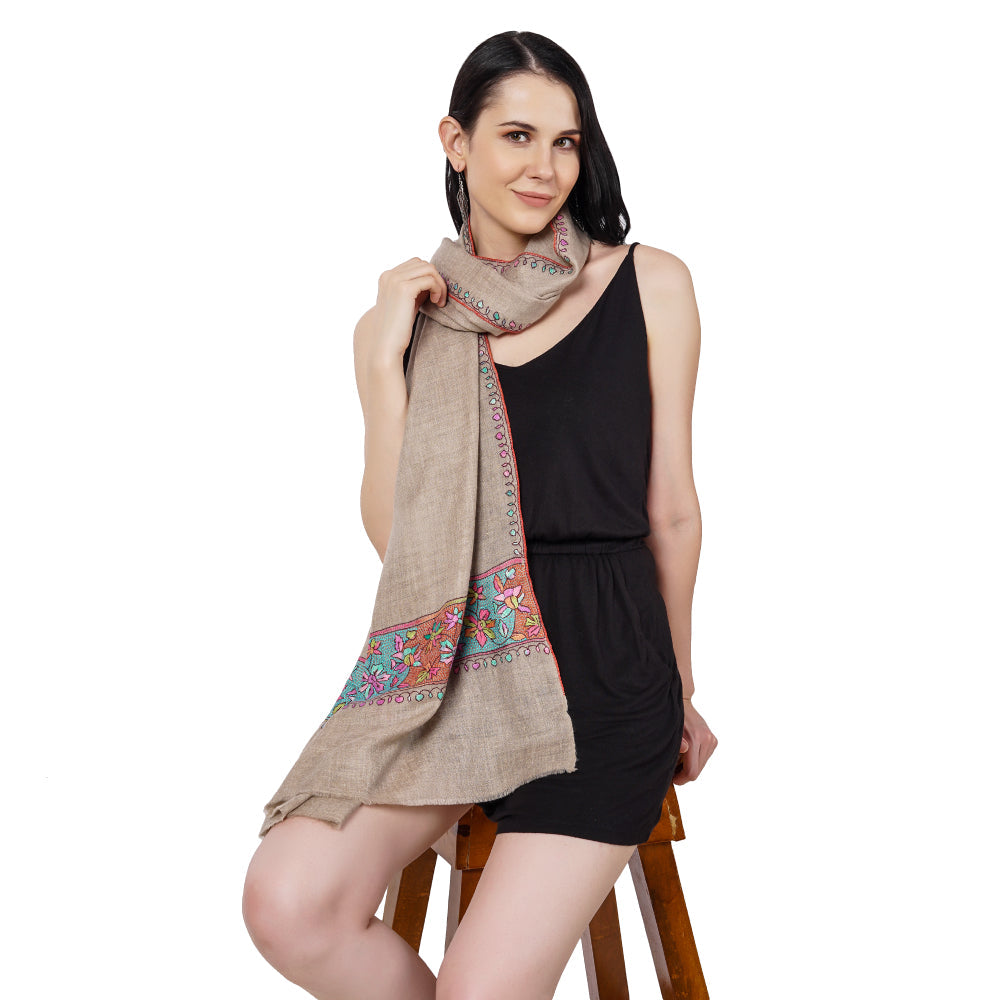
Unveiling the Origin of Pashmina Shawls: The Indian State Known for Their Exquisite Craftsmanship
Share
Pashmina shawls are a symbol of luxury and elegance that have been popular for centuries. These shawls are made from the soft and fine wool extracted from the underbelly of the Capra hircus goat found in the Himalayan region. The wool is meticulously collected and spun into yarn, which is then woven into shawls using traditional methods.
The softness and warmth of Pashmina shawls have made them a favorite among people worldwide. They are known for their lightweight texture and ability to provide warmth without feeling bulky. Pashmina shawls come in a range of colors, patterns, and designs, making them a versatile accessory that can be paired with a variety of outfits.
In Indian culture, Pashmina shawls are highly valued and have been a part of the country's heritage for centuries. They are often given as gifts during special occasions such as weddings and festivals. The intricate designs and patterns of Pashmina shawls showcase the craftsmanship and creativity of Indian artisans.
Despite their popularity, Pashmina shawls are expensive due to the high-quality wool and labor-intensive process of making them. However, their timeless beauty and durability make them a worthwhile investment that can be treasured for generations.

Also read: Weaving a Pashmina Shawl
Brief history of Pashmina shawls and its popularity

Pashmina shawls have a rich and fascinating history that spans centuries. The origins of Pashmina shawls can be traced back to the 3rd century BC when they were first mentioned in ancient Indian texts. These shawls were highly valued by the Mughal emperors and were often gifted to royalty and nobility.
During the 19th century, Pashmina shawls gained popularity in Europe, and they became a status symbol among the wealthy. The shawls were highly sought after for their fine quality and intricate designs, and they became a prized possession of many.
Today, Pashmina shawls are still highly valued for their luxurious texture, softness, and warmth. They are available in a range of colors and designs, and they are a popular accessory among fashion enthusiasts worldwide.
Despite their popularity, the production of Pashmina shawls is a labor-intensive process that requires skilled artisans to spin and weave the wool by hand. As a result, genuine Pashmina shawls are expensive, and there are many imitations in the market. Nonetheless, the beauty and quality of authentic Pashmina shawls continue to make them a highly sought-after item.
Also read: A Journey through time : The history of Pashmina Shawls
Importance of Pashmina shawls in Indian culture

Pashmina shawls have played an important role in Indian culture for centuries. They are a symbol of luxury and elegance and are highly valued for their fine quality and intricate designs.
In ancient times, Pashmina shawls were worn by royalty and nobility and were considered a status symbol. They were often gifted during weddings and other important occasions, and they were treasured possessions that were passed down from generation to generation.
The production of Pashmina shawls has been a significant source of income for many families in the Himalayan regions of India, where the goats are raised. Skilled artisans have been spinning and weaving Pashmina wool into shawls using traditional methods for centuries, passing down their techniques and knowledge from generation to generation.
Today, Pashmina shawls continue to be highly valued in Indian culture. They are often worn during special occasions such as weddings, festivals, and other celebrations. The intricate designs and patterns of Pashmina shawls showcase the craftsmanship and creativity of Indian artisans, making them a treasured and timeless piece of Indian heritage.
Also read: 30 Most frequently asked questions about Cashmere and Pashmina
What is Pashmina

Pashmina is a fine type of wool that comes from the underbelly of the Capra hircus goat, which is found in the Himalayan regions of Kashmir, India. The wool is highly valued for its softness, warmth, and lightweight texture. The term "Pashmina" is derived from the Persian word "Pashm," which means "soft gold."
Pashmina wool is obtained by combing the undercoat of the goats during the spring shedding season. The wool is then spun into yarn, which is used to make a variety of items such as shawls, scarves, and blankets. Pashmina wool is known for its exceptional quality, as it is thinner and softer than other types of wool.
Pashmina products, particularly Pashmina shawls, have gained worldwide popularity due to their luxurious texture and intricate designs. However, genuine Pashmina products can be expensive due to the labor-intensive process involved in obtaining and processing the wool. Nonetheless, the beauty and quality of Pashmina make it a highly sought-after material that is treasured for its timeless elegance and durability.
How Pashmina wool is extracted from goats

Pashmina wool is extracted from the underbelly of the Capra hircus goat, which is found in the Himalayan regions of India, Nepal, and Pakistan. The process of obtaining Pashmina wool is a labor-intensive and delicate process that requires great skill and care.
The wool is obtained by combing the undercoat of the goat during the spring shedding season. The goats are first washed and then tied down to prevent them from moving during the process. The combing process is done carefully to avoid damaging the delicate fibers of the wool. The wool is then sorted based on its quality and grade.
After the wool has been sorted, it is cleaned and dehaired to remove any coarse outer fibers. This process involves separating the soft undercoat fibers from the coarse outer fibers, leaving only the finest and softest Pashmina fibers.
The Pashmina fibers are then spun into yarn, which is used to make a variety of items such as shawls, scarves, and blankets. The entire process of obtaining and processing Pashmina wool is done by skilled artisans who have been trained in the traditional techniques of Pashmina wool production. The result is a luxurious and high-quality material that is treasured for its softness, warmth, and lightweight texture.
History of Pashmina Shawls

The history of Pashmina shawls can be traced back to the 3rd century BC, during the time of the Indus Valley Civilization. The shawls were initially made by hand in Kashmir and were known for their exceptional quality and luxurious texture. During the Mughal Empire, Pashmina shawls became highly prized and were used as gifts to foreign dignitaries. The popularity of Pashmina shawls continued to grow, and they became a symbol of luxury and status throughout the world. Today, Pashmina shawls are still highly valued and are considered a treasured possession due to their exquisite beauty and exceptional quality.
Also read: What is so special about Pashmina Shawl
Origins of Pashmina shawls in India

Pashmina shawls have been woven in India for centuries, and their origins can be traced back to the Kashmir region. The Kashmir valley, located in the Himalayan mountains, is known for its cold climate and harsh winters, which made warm clothing a necessity.
The art of weaving Pashmina shawls was brought to the Kashmir region by artisans who migrated from Central Asia. These artisans passed on their weaving techniques to the local people, who began to produce Pashmina shawls using the wool obtained from the Capra hircus goat.
During the Mughal Empire, Pashmina shawls became highly prized and were worn by royalty and wealthy nobles. The Mughals brought Persian and Central Asian designs and patterns to the Kashmiri weavers, who incorporated them into their own designs, creating a unique blend of styles.
Today, Pashmina shawls are still woven by skilled artisans in the Kashmir region, using traditional techniques and patterns. The wool is still obtained from the Capra hircus goat and is considered one of the finest and most luxurious fibers in the world. Pashmina shawls remain an important part of India's cultural heritage and are highly valued for their beauty and quality.
Evolution of Pashmina shawls

Pashmina shawls have evolved over the years to adapt to changing fashion trends and consumer preferences. In the past, Pashmina shawls were primarily worn for their warmth and durability, but today they are also prized for their beauty and elegance.
In the early years, Pashmina shawls were woven in simple designs and patterns, with limited colors and motifs. Over time, weavers began to incorporate more intricate designs and patterns, using a variety of colors and embroidery techniques to create unique and intricate shawls.
With the rise of the fashion industry, Pashmina shawls have become more versatile and are now available in a wide range of styles and designs. Today, Pashmina shawls are not only available in traditional patterns and designs but also in modern, contemporary designs that cater to younger generations.
New techniques have also been developed to enhance the quality and durability of Pashmina shawls. For instance, some weavers now use a blend of Pashmina wool with silk or other fibers to create shawls that are more lightweight and durable.
Despite these changes, Pashmina shawls remain a symbol of luxury and elegance and continue to be prized for their softness, warmth, and timeless beauty.
Significance of Pashmina shawls in Indian history and culture

Pashmina shawls hold great significance in Indian history and culture. These luxurious shawls have been a part of Indian heritage for centuries and are considered one of the country's most prized possessions.
In the past, Pashmina shawls were worn only by royalty and nobles, and were a symbol of wealth and status. They were also gifted to foreign dignitaries, and were highly valued for their exquisite beauty and exceptional quality.
In Indian culture, Pashmina shawls are still regarded as a luxurious and elegant accessory, and are often worn during special occasions and festivities. They are also considered a valuable family heirloom, and are often passed down from generation to generation.
The production of Pashmina shawls also holds great cultural significance. The art of weaving Pashmina shawls has been passed down from generation to generation in the Kashmir region, and is considered an important part of the area's cultural heritage.
Overall, Pashmina shawls are an integral part of India's rich history and culture, and continue to be highly valued for their beauty and quality.
Which State in India is Famous for Making Pashmina Shawls?

The state of Jammu and Kashmir in northern India is famous for making Pashmina shawls. The region has a long history of producing high-quality Pashmina wool, which is woven into luxurious shawls by skilled artisans. The city of Srinagar in Kashmir is particularly renowned for its Pashmina shawls, which are prized for their softness, warmth, and intricate designs. However, Pashmina shawls are also produced in other parts of India, such as Himachal Pradesh and Uttar Pradesh, though they may not be as well-known as those from Kashmir.
Introduction to the state of Jammu & Kashmir
Pashmina shawls are one of India's most prized possessions, and are produced in several states across the country. The most famous state for producing Pashmina shawls is Jammu and Kashmir, located in northern India. The region is known for its high-quality Pashmina wool, which is woven into luxurious shawls by skilled artisans. The city of Srinagar in Kashmir is particularly renowned for its Pashmina shawls, which are prized for their softness, warmth, and intricate designs.
Kashmir is famous for Pashmina shawls because of the region's unique climate, geography, and cultural heritage. Pashmina wool, which is used to make these shawls, comes from the Changthangi goat that is found only in the high-altitude regions of Ladakh, in the northern part of Jammu and Kashmir. These goats have a thick, warm coat of fine hair that protects them from the harsh winter conditions, and this hair is harvested in the spring when it is naturally shed.
The wool is then hand-spun by skilled artisans using traditional methods, resulting in a yarn that is incredibly soft, fine, and lightweight. These qualities make Pashmina wool highly prized for making shawls, scarves, and other clothing items that are warm yet lightweight and comfortable to wear.
The art of Pashmina shawl weaving has been a part of Kashmir's cultural heritage for centuries, and the region has a long history of producing some of the finest shawls in the world. The Mughal emperors of India were known to be great patrons of the Pashmina shawl industry, and it was during their reign that the shawls gained widespread popularity.
Today, Pashmina shawls from Kashmir are highly sought after by fashion lovers and collectors all over the world. The shawls are known for their exquisite beauty, intricate designs, and softness, which are a result of the skilled craftsmanship and high-quality materials used in their production.
The production of Pashmina shawls is also an important source of income for many artisans in Kashmir, who have inherited the craft from their forefathers. The industry provides employment opportunities to thousands of people, and has helped to support the local economy of the region.
Overall, Kashmir's unique climate and cultural heritage have made it the premier destination for Pashmina shawl production, and the region's skilled artisans continue to produce some of the finest shawls in the world today.
How are Pashmina Shawls Made?

The process of making a Pashmina shawl is a highly skilled and intricate craft that requires patience and attention to detail. It involves several steps, from harvesting the wool to weaving the final product.
The wool used to make Pashmina shawls comes from the underbelly of the Changthangi goat, which is found in the high-altitude regions of the Himalayas. The wool is collected during the spring when the goats naturally shed their hair. The wool is then cleaned, de-haired, and spun by hand to create fine yarn.
Once the yarn is ready, it is woven into the shawl using a handloom. The weavers use traditional techniques and patterns that have been passed down for generations, and each shawl can take several weeks or even months to complete.
After weaving, the shawl is washed and finished to enhance its softness and luster. This process involves brushing the shawl with thistle combs, which gives it a distinctive fluffy texture and enhances its warmth and softness.
The final product is a beautiful, lightweight shawl that is incredibly soft and warm. Pashmina shawls are renowned for their intricate designs, which often feature floral or paisley patterns, and are available in a wide range of colors and styles.
Overall, the process of making a Pashmina shawl is a labor-intensive and time-consuming craft that requires skill and dedication. However, the end result is a beautiful, luxurious product that is highly prized for its softness, warmth, and beauty.
Also read: The making of Pashmina Shawls
Step-by-step process of making Pashmina shawls

The process of making Pashmina shawls is a highly skilled and time-consuming craft that involves several steps. Here is a step-by-step guide to making a Pashmina shawl:
-
Collecting Pashmina Wool: The process begins by collecting the wool from the underbelly of the Changthangi goat, which is found in the high-altitude regions of the Himalayas. The wool is collected during the spring when the goats naturally shed their hair.
-
Cleaning and De-Hairing: The collected wool is then cleaned and de-haired by hand to remove any impurities and create a fine, soft yarn.
-
Spinning the Yarn: The de-haired wool is then spun by hand to create fine, soft yarn that will be used to weave the shawl.
-
Weaving the Shawl: The yarn is woven into the shawl using a handloom. The weavers use traditional techniques and patterns that have been passed down for generations.
-
Washing and Finishing: Once the shawl is woven, it is washed and finished to enhance its softness and luster. This involves brushing the shawl with thistle combs, which gives it a distinctive fluffy texture and enhances its warmth and softness.
-
Final Touches: After the shawl is finished, it may undergo further processing such as adding tassels or embroidery.
Overall, the process of making a Pashmina shawl is a labor-intensive and time-consuming craft that requires skill and dedication. However, the end result is a beautiful, luxurious product that is highly prized for its softness, warmth, and beauty.
Tools and equipment required in making Pashmina shawls
The process of making Pashmina shawls involves the use of several tools and equipment. Here are some of the essential tools and equipment required:
-
Handloom: The handloom is the most important piece of equipment in weaving the Pashmina shawl. It is used to interlace the yarn to create the fabric.
-
Spinning Wheel: The spinning wheel is used to spin the Pashmina yarn into fine, soft threads.
-
Thistle Comb: The thistle comb is used to brush the finished shawl, which gives it a fluffy texture and enhances its softness.
-
Scissors: Scissors are used to trim the loose ends of the shawl and to create the fringes.
-
Needles: Needles are used for the embroidery work that is sometimes done on Pashmina shawls.
-
Dyes: Natural dyes such as indigo, madder, and pomegranate are used to dye the Pashmina yarn into different colors.
Overall, the tools and equipment required for making Pashmina shawls are simple and traditional. The focus is on skill and craftsmanship, rather than modern technology.
Buying Pashmina Shawls: What to Look For?
When buying Pashmina shawls, it's important to look for certain qualities such as softness, warmth, and durability. Additionally, check the authenticity of the product and the reputation of the seller. Look for certifications and do your research before making a purchase.
How to distinguish between genuine and fake Pashmina shawls
With the growing popularity of Pashmina shawls, there are also many counterfeit products in the market. Here are some tips to distinguish between genuine and fake Pashmina shawls:
-
Price: If the price of the Pashmina shawl is too low, it's probably a fake. Authentic Pashmina shawls are made from rare and valuable wool, making them expensive.
-
Labeling: Check the label on the shawl. Genuine Pashmina shawls should have a label indicating the type of wool used, its origin, and its percentage in the product.
-
Feel: Pashmina shawls are known for their softness and warmth. If the shawl feels scratchy or stiff, it's probably not genuine.
-
Sheen: Genuine Pashmina shawls have a subtle sheen, while fake ones may have a bright, shiny appearance.
-
Burn Test: A quick burn test can help to identify genuine Pashmina shawls. Burn a few strands of the shawl with a lighter, and if it smells like burnt hair and leaves behind a grey ash, it's most likely a genuine Pashmina shawl. If it smells like plastic and leaves behind black ash, it's a fake.
-
Water Test: Place a drop of water on the shawl and wait for a few seconds. If the water is absorbed, it's genuine. If it beads up or rolls off, it's likely fake.
By keeping these tips in mind, you can ensure that you are purchasing a genuine Pashmina shawl and not being tricked into buying a fake one.
Conclusion
In conclusion, Pashmina shawls are an integral part of Indian culture and have been valued for their luxurious texture and warmth for centuries. The wool used to make Pashmina shawls is sourced from the Changthangi goats of the Himalayan region, and the shawls are handcrafted using traditional techniques. Kashmir is the most famous state in India for producing Pashmina shawls, but other states like Himachal Pradesh, Punjab, Rajasthan, and Uttar Pradesh also have their own unique variations. When buying Pashmina shawls, it is important to consider factors such as the quality of the wool, the craftsmanship, and the authenticity of the product. With a little bit of knowledge and research, one can find the perfect Pashmina shawl to add to their collection.




